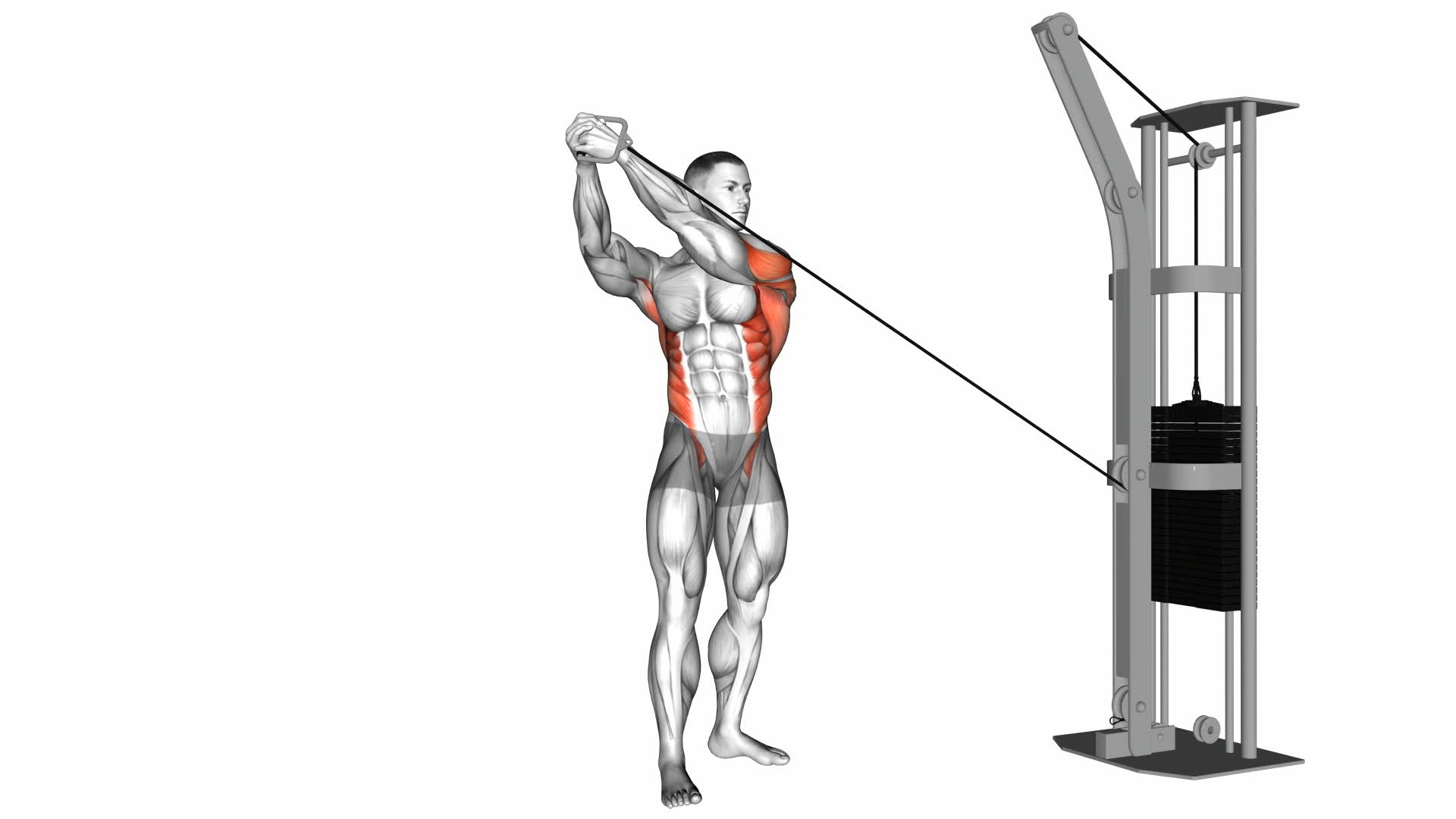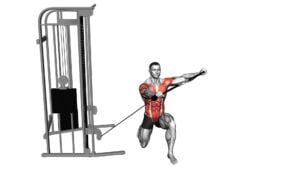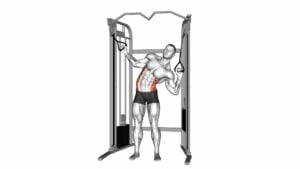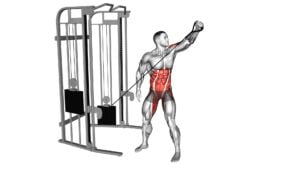Cable Standing Lift – Video Exercise Guide & Tips

Looking to take your workout to the next level? Check out our Cable Standing Lift video exercise guide and tips!
Watch This Exercise Video
This informative guide will walk you through the benefits, proper form, and variations of the Cable Standing Lift.
You'll also find valuable tips for maximizing your results and avoiding common mistakes.
Get ready to amp up your exercise routine and achieve your fitness goals with the Cable Standing Lift!
Key Takeaways
- Cable standing lift activates and strengthens various muscle groups in the body.
- Proper form, including stable and controlled movement, is crucial for maximizing the benefits of cable standing lift.
- There are variations of cable standing lift that target different muscle groups.
- Maximizing results from cable standing lift requires focusing on proper technique, stability, and muscle engagement while avoiding common mistakes.
Benefits of Cable Standing Lift
You can experience multiple benefits from incorporating the cable standing lift into your workout routine. This exercise is highly effective in activating and strengthening various muscle groups in your body. The cable standing lift primarily targets your upper body, including your shoulders, chest, and arms. As you perform the exercise, you'll feel a significant activation of these muscles, helping you build strength and definition.
One of the great things about the cable standing lift is that it allows you to adjust the resistance according to your fitness level. This means that whether you're a beginner or an advanced gym-goer, you can easily find the right weight to challenge yourself and continue progressing.
To perform the cable standing lift, you'll need a cable machine. This equipment consists of a weight stack, pulleys, and cables attached to different handles or attachments. By using the cable machine, you can perform a wide range of exercises, including the cable standing lift.
Incorporating the cable standing lift into your workout routine not only helps you build strength and muscle definition but also improves your overall functional fitness. It engages multiple muscle groups simultaneously, enhancing your coordination, stability, and balance.
Proper Form for Cable Standing Lift
To ensure proper form during the cable standing lift, it's important to focus on maintaining a stable and controlled movement throughout the exercise. Proper technique is crucial to maximize the benefits and avoid any potential injuries.
One of the most common mistakes people make is using momentum to lift the weight instead of relying on their muscles. This not only reduces the effectiveness of the exercise but also increases the risk of strain or injury.
To perform the cable standing lift with proper form, start by standing with your feet shoulder-width apart and knees slightly bent. Keep your core engaged and your back straight throughout the movement. Avoid rounding your shoulders or leaning forward.
As you lift the cable, exhale and squeeze your targeted muscle group, whether it's your biceps, triceps, or shoulders. Maintain control as you lower the weight, inhaling on the way down.
It's important to use a weight that challenges you but still allows you to maintain proper form. Remember, quality reps are more important than quantity, so focus on performing the exercise with proper technique to get the most out of your cable standing lift.
Variations of Cable Standing Lift
There are several variations of the cable standing lift that can help you target different muscle groups. Here are four variations that you can incorporate into your workout routine to add variety and challenge:
- Single-arm cable standing lift: This variation involves using a single cable attachment and focusing on one side of your body at a time. It helps improve unilateral strength and stability.
- High cable standing lift: By adjusting the cable to a higher position, you can target your upper back and shoulders more effectively. This variation is great for building strength and definition in your upper body.
- Low cable standing lift: Lowering the cable attachment allows you to target your glutes and hamstrings. This variation is particularly beneficial for strengthening your lower body and improving overall stability.
- Rotational cable standing lift: This variation involves rotating your body as you perform the lift. It engages your core muscles and improves rotational strength and stability.
To perform any of these cable standing lift variations, make sure to maintain proper technique. Keep your core engaged, maintain a neutral spine, and use controlled movements throughout the exercise. Adjust the weight and resistance to match your fitness level and gradually increase intensity over time.
Remember to always consult with a fitness professional before attempting new exercises.
Tips for Maximizing Cable Standing Lift Results
For optimal results with the cable standing lift, focus on incorporating proper form and technique throughout the exercise. This will help target the intended muscles and avoid unnecessary strain or injury.
To improve strength with the cable standing lift, consider these effective techniques. Firstly, ensure that you have a stable stance with your feet shoulder-width apart and knees slightly bent. This will provide a solid base of support and allow for better control of the weight. Additionally, engage your core muscles throughout the movement to maintain stability and protect your lower back.
It's also important to avoid using momentum or swinging the weight. Instead, focus on a slow and controlled movement, emphasizing the muscle contraction during both the lifting and lowering phases. By maintaining tension on the muscles throughout the exercise, you can maximize the effectiveness and strength-building potential of the cable standing lift.
Now, let's move on to the next section and discuss common mistakes to avoid during the cable standing lift, which can hinder your progress and potentially lead to injury.
Common Mistakes to Avoid During Cable Standing Lift
To prevent hindering your progress and potentially leading to injury, make sure to avoid these common mistakes during the cable standing lift.
- Using too much weight: One of the most common mistakes is using weights that are too heavy. This can compromise your form and increase the risk of injury. Start with a weight that allows you to perform the exercise with proper technique.
- Not engaging your core: Neglecting to engage your core can put unnecessary strain on your lower back. Remember to brace your abs throughout the exercise to stabilize your spine and protect your back.
- Using momentum: Swinging the weight or using momentum to lift it's a common mistake that reduces the effectiveness of the exercise. Focus on controlled movements and use your muscles to lift the weight, rather than relying on momentum.
- Allowing the cables to pull you forward: It's important to maintain proper posture and control throughout the movement. Avoid leaning forward or allowing the cables to pull you off balance. Stand tall and keep your shoulders back.
Frequently Asked Questions
How Much Weight Should I Use for the Cable Standing Lift Exercise?
To determine the appropriate weight for the cable standing lift exercise, you need to focus on proper form first. Without context, it's important to remember that the weight should challenge you without compromising your technique.
Start with a light to moderate weight and gradually increase it as you become more comfortable and confident.
Listen to your body and adjust accordingly. Remember, the key is to maintain proper form throughout the exercise.
Can I Perform the Cable Standing Lift Exercise if I Have Lower Back Pain?
If you have lower back pain, it's important to be cautious when performing the cable standing lift exercise. Putting strain on your lower back could worsen the pain.
However, there are alternatives for lower back pain that you can consider. Cable exercises, in general, provide benefits like improved strength and stability.
It's recommended to consult with a healthcare professional or a certified trainer to find suitable exercises that won't aggravate your lower back pain.
How Often Should I Incorporate the Cable Standing Lift Exercise Into My Workout Routine?
To get the most out of your workout routine, incorporating the cable standing lift exercise is a great idea. This exercise offers numerous benefits, such as improving overall strength, targeting multiple muscle groups, and enhancing core stability.
It's important to perform the exercise with proper form and technique to avoid injury. By following the correct steps, you can maximize the effectiveness of the cable standing lift and achieve your fitness goals.
Is the Cable Standing Lift Exercise Suitable for Beginners?
The cable standing lift exercise can be suitable for beginners. It offers several benefits, including improved upper body strength and core stability.
To perform the exercise with proper form, stand with your feet shoulder-width apart, grasp the cable handle with both hands, and lift it straight up towards your chest while keeping your back straight.
Start with a lighter weight and focus on maintaining control throughout the movement.
Can I Modify the Cable Standing Lift Exercise if I Don't Have Access to a Cable Machine?
If you don't have access to a cable machine, there are alternative exercises you can do to work similar muscle groups.
Instead of the cable standing lift, you can try dumbbell or resistance band exercises like the standing shoulder press or lateral raises.
These exercises target the shoulders and arms just like the cable standing lift.
While it's important to modify exercises based on available equipment, make sure to maintain proper form and technique to avoid injury.
Conclusion
In conclusion, the cable standing lift is a highly effective exercise that offers numerous benefits for both beginners and advanced fitness enthusiasts. By maintaining proper form and incorporating variations, individuals can target specific muscle groups and maximize their results.
It's important to avoid common mistakes and follow the tips provided to ensure a safe and effective workout. Incorporating the cable standing lift into your fitness routine can help improve strength, stability, and overall physique.

Author
Years ago, the spark of my life’s passion ignited in my mind the moment I stepped into the local gym for the first time. The inaugural bead of perspiration, the initial endeavor, the very first surge of endorphins, and a sense of pride that washed over me post-workout marked the beginning of my deep-seated interest in strength sports, fitness, and sports nutrition. This very curiosity blossomed rapidly into a profound fascination, propelling me to earn a Master’s degree in Physical Education from the Academy of Physical Education in Krakow, followed by a Sports Manager diploma from the Jagiellonian University. My journey of growth led me to gain more specialized qualifications, such as being a certified personal trainer with a focus on sports dietetics, a lifeguard, and an instructor for wellness and corrective gymnastics. Theoretical knowledge paired seamlessly with practical experience, reinforcing my belief that the transformation of individuals under my guidance was also a reflection of my personal growth. This belief holds true even today. Each day, I strive to push the boundaries and explore new realms. These realms gently elevate me to greater heights. The unique combination of passion for my field and the continuous quest for growth fuels my drive to break new ground.







